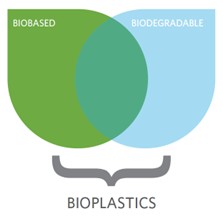
Bioplastics are another sustainable material of choice due to benefits they bring at both the beginning and end of life processes. Biobased bioplastics typically lead to a reduction in a product’s carbon footprint and global warming potential (GWP) because the biobased carbon content is typically CO2 captured from the atmosphere through plant growth.
Compostable bioplastics, when disposed of properly, reduce the amount of waste sent to landfill and can help to bring more organic scraps (food and yard waste, for example) to commercial composting facilities while completely degrading back into useful compost themselves.
They are used in the same ways as other plastics in packaging, agriculture, medical, automotive parts, 3D printing and more.
The Bioplastics Division of PLASTICS works to promote the development of bioplastics as an integral part of the plastics industry by:
Bioplastics Week is our annual social media campaign in which we aim to garner the voices of the bioplastics industry to bring awareness to bioplastics. Through our social media platforms, and the platforms of all that participate, we share educational content about material or product innovations, applications for bioplastics, barriers and opportunities for growth, and how to dispose of bioplastic products properly to keep them in the circular economy. Participation is as simple as using the hashtag #BioplasticsWeek in a post during the week!
Innovation in Bioplastics Award
The Innovation in Bioplastics Award is presented annually by the PLASTICS Bioplastics Division to recognize outstanding innovations and to celebrate the unique and creative applications of bioplastics materials, products, or processes by a company. Entries are judged on innovation, sustainability and impact on the marketplace.
Watching: Bioplastics, Plastics Market Watch
A phase two of the Bioplastics Market Watch Report, Watching: Bioplastics provides valuable updates on the status of bioplastics in the marketplace as well as at research labs around the country. Uncover information on innovation and advancement, market intelligence, consumer perceptions, emerging markets and public policy. Bioplastics are increasingly being used in industry sectors beyond bottling and packaging with many brands discovering their diversity and flexibility. The entire plastics supply chain can benefit from these insights.
Bioplastics: Plastics Market Watch
Bioplastics are plastics that either: originate from a renewable resource, are biodegradable, or are both. As new applications and technologies are developed, bioplastics represent an evolution within the plastics marketplace. Bioplastics are part of the plastics’ growth story that is inspiring brand owners and manufacturers to find new applications and solutions for products. What can be made of bioplastics graphic: [English] [Spanish]
Position Paper on Degradable Additives
This position paper outlines issues and questions of concern in order to support consumers, retailers and the plastics industry in identifying unsubstantiated and misleading product claims around degradability and biodegradability of plastics.
Position on Certified Commercially Compostable Bioplastics
This position statement identifies the credentials needed for a bioplastic to be considered certified commercially compostable and supports composting of this material to help meet sustainability goals.
Industrial Compostability Claims Checklist
The Federal Trade Commission’s Green Guide provides direction to companies making claims about industrial compostability. This guidance document provides a handy checklist and examples about things to consider when putting claims on product packaging.
Bioplastics Simplified: Attributes of Biobased and Biodegradable Plastics
The term “bioplastics” describes a wide range of materials. This paper discusses the growing field of bioplastics and how material innovations can offer environmental advantages.
Understanding Biobased Carbon Content
Communicating biobased content of a product can be confusing due to terminology inconsistencies and differences in measurement methods. This resource walks through the basics of biobased content test methods, certifications, as well as relevant terms and definitions. We are in the process of updating this resource.
Life Cycle Analysis Primer: What, Why and How
This guide will describe what constitutes an LCA, what the benefits and limitations of different types of LCAs and related tools are, and how to interpret and communicate LCA results.
Voluntary Guidelines on Bioplastics Marketing Claims
All companies have the responsibility to ensure that environmental claims used in marketing and promotion are truthful and evidence-based, not deceptive or unfair. These recommendations are voluntary guidelines and general principles for those marketing bioplastics, informed by the Federal Trade Commission (FTC) “Guides for the Use of Environmental Marketing Claims” (Green Guides) and relevant state laws or regulations.
As part of President Biden’s Executive Order (EO) on “Advancing Biotechnology and Biomanufacturing Innovation for a Sustainable, Safe, and Secure American Bioeconomy”, the goal to “demonstrate and deploy cost-effective and sustainable routes to convert bio-based feedstocks into recyclable-by-design polymers that can displace more than 90% of today’s plastics and other commercial polymers at scale” was included. This report walks through PLASTICS response to and recommendations for this goal.